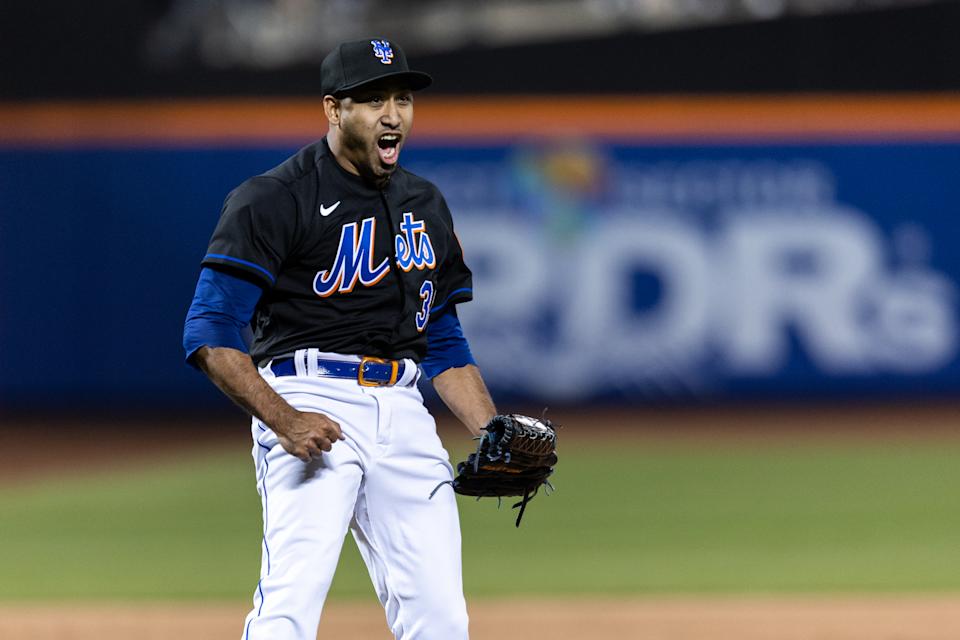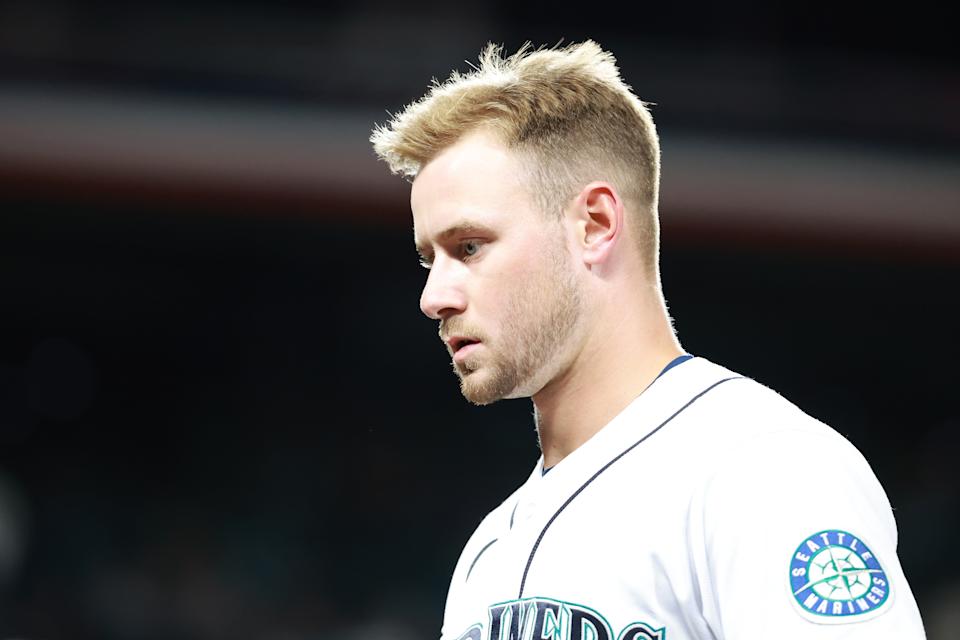(This story has been updated to reflect the Mariners’ demotion of Jarred Kelenic.)
When the Seattle Mariners face the New York Mets on Friday, Robinson Cano will not be there, and now neither will Jarred Kelenic. A seismic December 2018 trade that shifted the course of both franchises is back under the microscope this weekend after the Mets’ one-time top pick was optioned to Triple-A before getting to face his former future team for the first time.
Ships passing in the night, the deal solidified the polar opposite priorities of the two franchises at the time. The Mets were trying to break out of fourth place with big, bold names. The Mariners were admitting defeat on one push at contention and openly committing to a youth-focused rebuild.
The Mariners sent closer Edwin Diaz, legendary but aging second baseman Robinson Cano and cash to the Mets for outfielder Kelenic, the No. 6 overall pick less than six months prior, along with a pitching prospect named Justin Dunn and a raft of jetsam that included Jay Bruce and Anthony Swarzak.
If “Moneyball” was the tipping point that began to shift fan understanding and public opinion toward MLB front offices’ emphasis on younger players and data-backed value metrics, this trade was the end of the journey. The Mets received by far the two most famous, most accomplished players in the deal, but their fans erupted in great billowing plumes of consternation that could be seen from space.
Kelenic, they understood, was the most prized piece in the trade by industry standards. And if he turned out to be a star who helped Seattle contend while making the relative pittance of pre-arbitration or arbitration salaries? Well the trade could quickly become the sort of cruel joke that Mets fans dread — another pathetic reminder of big dreams and small results like Bobby Bonilla’s comical annual payout.
Still, the compulsion to pronounce a winner and a loser was premature, and remains that way three seasons later. For all the upheaval and rapid recalibrations in the meantime, the deal still hinges on the one player who hasn’t yet played in front of the faithful in Queens.


Teams in transition
It’s impossible to assess the blockbuster Diaz-Cano-Kelenic swap and its aftermath without talking about the front office leadership groups making the decisions.
When he took over prior to 2016, GM Jerry Dipoto inherited a Mariners team that couldn’t quite get over the hump and kept running into the same issue. With his biggest stars on the wrong side of 30, he pulled the plug in a big way after 2018. Of course, he was perhaps more inclined to move on from Cano halfway through his 10-year, $240 million deal because he did not have anything to do with bringing him to Seattle.
Lo and behold, he found a trading partner who had a lot to do with Cano’s Seattle deal: Brodie Van Wagenen, Cano’s former agent, had performed an unconventional mid-career leap into a GM job. He was under pressure from the Wilpon family that then owned the Mets to field a contender around a stacked rotation that included Jacob deGrom, Noah Syndergaard and Zack Wheeler.
Dipoto has been given the chance to see his vision out, with the 2021 Mariners showing the first glimpse of competitiveness, and the 2022 Mariners leaning fully into the next wave of talent headlined by Kelenic, Julio Rodriguez and George Kirby. Dipoto used Justin Dunn — who amassed a middling 3.94 ERA across 102 2/3 injury-interrupted innings in Seattle — as part of a package to supplement the youth with veteran hitters Jesse Winker and Eugenio Suarez. Everyone else in the deal moved on or washed out.
The Mets … have changed just about everything. Steve Cohen bought the team from the Wilpons and installed a new front office — which has already turned over amid much turbulence — and new big-money strategies. The result is that another GM, Billy Eppler, had no problem cutting ties with Cano earlier this month after another steroid suspension cost him all of 2021. (Van Wagenen, amusingly, is back to his duties as Cano’s agent and reportedly helped him ink a deal with the San Diego Padres on Friday.)
Diaz suffered through a miserable, homer-plagued first season in New York. He ran up a 5.59 ERA and blew seven saves as the Mets missed the playoffs by three games. That kicked off a second wave of existential panic over the trade, but he has since returned to the ranks of MLB’s elite relievers. Since the start of 2020, Diaz has a 2.81 ERA and 10 blown saves total. His K-BB%, a telling statistic of dominance, is sixth among relievers in that timeframe. If you counted the number of relievers you’d want over Diaz in 2022, it would fit on one hand.
And that could prove important. The 2022 Mets look like serious contenders, and Diaz could affect their place on the win curve as he approaches free agency.


Will Jarred Kelenic make the Mets regret the deal?
So to recap: The Mets haven’t made the playoffs since the deal, but Diaz is closing games for a team soaring atop the NL East. Cano has been suspended again and then paid handsomely to go away. Most of the other players involved in the deal are gone and irrelevant.
That leaves Kelenic.
He’s 22 years old and 123 games into his major-league career. After thoroughly dominating every stop of the minors, he arrived in the big leagues with a whimper. Despite flashes of the compact home run swing that was promised, Kelenic has batted .173/.256/.338 in the majors. His strikeout rate was a worrisome 28.1% in 93 games last season, and ballooned to 37.5% in 30 games in 2022 before the Mariners sent him down to Triple-A on Friday afternoon.
What’s especially perplexing is the way the struggles have happened. He’s not hacking at horrible pitches — his plate discipline numbers are almost dead on the league average across the board. He’s just A) missing way too many of them and B) not crushing the ones he does hit.
You probably don’t need further explanation to understand that’s a pretty dreadful combo, but a deeper look under the hood makes things worse. In 2022, Kelenic’s 67.8% contact rate is 17th-worst among hitters who have swung at least 150 times. That’s not necessarily a death sentence, but hitters who make it work in this range all have one thing in common: They hit the ball very, very hard. Giancarlo Stanton, Javier Baez, Brandon Lowe and Tyler O’Neill all live in this area. Their average exit velocities range from 89 mph to 98 mph (lol, OK, Giancarlo).
Kelenic is very capable of that — only 4% of the league has managed to hit a ball harder than his max exit velocity of 114 mph. But he very rarely gets there. His average exit velocity is a painfully bad 84.5 mph, which is better than only 5% of the league. Combining this lack of contact and bad contact is pretty much only sustainable in the majors if you are a defensively savvy backup catcher.
What he’s been doing instead of hitting the ball well is popping it up. He has the third-worst pop-up rate in MLB among hitters with 80 or more plate appearances. And a lot of them are coming on pitches he should mash. In advantageous counts, on dull low-90s heat. On hanging breaking balls down the pipe. His numbers against offspeed pitches are under water, which makes you wonder about his bat control and adaptability against major-league offerings.
Still, it’s only 123 games. There’s enough capability here that you’d expect it to get better, but there are also too many glaring issues to not be extremely worried.
Owing to baseball’s penchant for rapid recalibrations, any honest assessment would conclude that we’re not far off from where we started. There are no winners or losers yet. We don’t know if the Mets will reap any reward from bringing in the stars. And we don’t know if Kelenic will wind up being a painful price to pay.
What we know for sure: This is the Jarred Kelenic trade. And it will be remembered for whatever Kelenic becomes.
